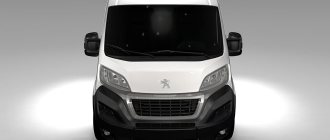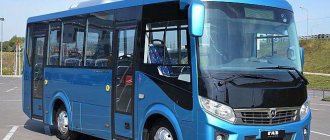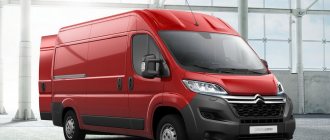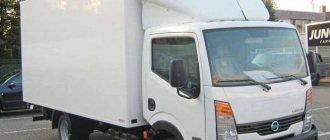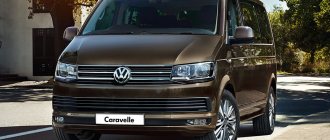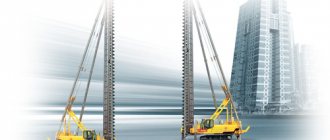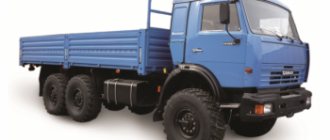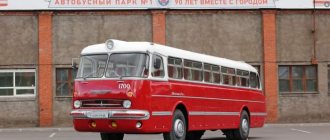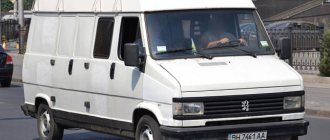Initially, the manufacturer conceived the Peugeot Partner Tipi as a van for small-sized cargo. The new version is much more adapted for everyday needs and is therefore suitable for family travel. When thinking through the details, the safety of the driver and passengers comes to the fore, which will be appreciated by families with small children.
Before buying, the main thing is to pay attention not only to the design, but also to the technical parameters in order to decide whether the car is suitable.
Design
Peugeot has always been famous for its creative design ideas. The appearance of the Peugeot Partner Tepee is quite memorable - a smiling silhouette, triangular headlights and a huge bumper with a silver insert.
The hood of the car is very flat and compact, which causes some inconvenience during maintenance. However, this is more than compensated for by the huge windshield. The visibility of the French “heel” is simply gorgeous, as noted by the owners’ reviews. The Peugeot Partner Tipi has a black roof with roof rails. A panorama setting is available as an option.
Note that the Peugeot Partner Tepee has recently undergone a restyling. You can see what the updated Tipi looks like in the photo below.
The French slightly changed the shape of the optics, bumper and gave the hood more relief. The radiator grille has become more pronounced, with a chrome trim. Above the fog lights (which have become more compact) there is a strip of running lights.
Price of new and used Peugeot Partner
On the Russian market, Peugeot Partner is offered in Outdoor and Active trim levels. Basic equipment of the car includes ABS, EBD, AFU systems, central locking, radio preparation, engine protection, halogen headlights, 2 airbags, fabric trim, R15 wheels and front electric windows.
The minimum cost of a Peugeot Partner (cargo version) starts from 962,000 rubles (price taking into account the discount under the trade-in program). Without specialized offers, you will have to pay about 1,032-1,040 million rubles for a car. The Tepee version will cost more – from 1.13 million rubles.
The Outdoor package additionally included an advanced multimedia system with Mirror Link technology and separate rear seats. The cost of such a car starts from 1.10 million rubles.
There are quite a lot of used Peugeot Partners on the Russian market. Model cost:
- 1998-2000 – 100-200 thousand rubles;
- 2007-2009 – 310-400 thousand rubles;
- 2013-2015 – 490-800 thousand rubles.
Purchase criteria for a used Peugeot Partner
When purchasing a used Peugeot Partner, you should pay special attention to the following elements:
- rear axle. The most common problems occur with wheel bearings;
- stabilizer bushings and struts on the front axle;
- support bearings of the front struts;
- power steering;
- operation of electrical equipment
- sliding door opening mechanisms.
Salon
The interior design is modest. It's no secret that the Tipi was developed on the basis of the Partner truck. There is no need to think about luxurious trim and leather seats - everything is as simple and practical as possible. The center console may have a small multimedia display with navigation. The center console is equipped with a radio and an air conditioning control unit. What’s noteworthy is that the gearshift lever is part of a continuation of the panel.
Yes, he doesn't come straight out of it. But the characteristic “beard” that stretches across the interior is not here. This allows you to increase the free space in the car. The seating position is almost captain’s, but a lot of adjustments allow the driver to adjust everything as much as possible “for himself.” There are niches and glove compartments everywhere - you won't have any questions about where to put your things. The trunk is designed for 675 liters. If necessary, its volume can be increased to 1350 liters. By the way, the carrying capacity of the “French” is as much as 650 kilograms. The vehicle has the same platform as its cargo counterpart. Therefore, the car can easily withstand significant loads.
A special feature of the Peugeot Tipi is the panoramic roof (shown in the photo below), available as an option. It consists of four glasses - it looks very unusual. The windows have a tint film, thanks to which the interior does not heat up in the heat.
Another “secret” of this car is the built-in flavor capsule. It is built into the air duct deflectors. As it enters, the air becomes saturated with the pleasant aroma of citrus fruits. We also note that, as an option, the manufacturer can equip the Tipi with an air conditioning system (two-zone), tire pressure, rain and light sensors. Electric windows are available as standard.
Model history
The model was first developed in 1996 and presented in the M49 van body. It was produced in 2 modifications - passenger and cargo, which provided a wide range of practical operation of the vehicle. Both petrol (1.1 l, 1.4 l, 1.6 l, 1.8 l) and diesel (1.9D, 1.6 HDi, 2.0 HDi) internal combustion engines were used as power units for the first generation of cars.
Generation 1996
The first Peugeot Partner was produced from 1996 to 2002, after which it received an updated body and a redesigned design as a result of restyling. The model was distinguished by high build quality. Its “Sibling” is the co-platform Citroen Berlingo. With compact dimensions of 4135x1820x1725 mm, the model is characterized by maneuverability and cargo capabilities (versions from 800 to 1200 kg), so it confidently competes with all other representatives of this class.
After the update, which was carried out 6 years later, the car began to be produced in a modified M59 body, and the modernization affected not only the dashboard, radiator grille and front bumper, but also the design. Turbodiesel engines with Common Rail 2.0 HDI were added to the power units. The last changes to the first generation of Peugeot occurred in 2004, when the model received the name Origin and new engines 1.6 16v (TU5JP4) and a turbodiesel 1.6 HDi (DV6) were added to the line of internal combustion engines.
Generation 2008
The second version of the Peugeot Partner was released in 2008 and is known under the code name B9. The new model was qualitatively different from the previous version, since it was designed on a new platform. It is noteworthy that the new Peugeot had a wide range of load capacity options - from 600 to 1200 kg.
In the basic configuration, it was equipped with two gasoline engines - 1.6 16v 110 hp. (TU5JP4) and 1.6 VTi 120 hp. (EP6C PSA/BMW). New options have appeared with a 1.6 HDi diesel engine with a power of 75-120 hp, and all engines are resistant to high operating loads.
The new product was positioned more as a passenger version, which was the reason for the qualitative improvement in the interior. Features include the appearance of embossed body lines, enlarged fenders and exterior rear-view mirrors. In the basic version, all models are equipped with airbags, Isofix mounts for child seats, as well as the AW complex for automatically interrupting the gasoline supply in the event of an accident.
Specifications
Peugeot Partner Tipi has a wide range of engines. There are both diesel and gasoline units here. Let's start with the last ones. The base unit is a 1.4-liter four-cylinder unit. Its maximum power is only 75 forces. Of course, with such an engine the car will have sluggish technical characteristics. The Peugeot Partner Tipi 1.4 accelerates to hundreds in 17.5 seconds. Maximum speed is 148 kilometers per hour. How much gasoline does the Peugeot Partner Tipi consume? Fuel consumption is about 7.5 liters per 100 kilometers.
The average in the line is a 1.6-liter unit with 109 horsepower. With it, the car reaches 100 kilometers per hour in 12.2 seconds. The maximum speed is 160 kilometers per hour. What is noteworthy is that this engine consumes the same amount as the previous, 75-horsepower unit.
The flagship in the petrol line is the 1.8i unit. Its power is 147 horsepower. Acceleration to hundreds takes less than nine seconds, and the top speed is limited to 170 kilometers per hour. Fuel consumption in mixed mode does not exceed nine liters.
Review Peugeot 1.6-16V - 90hp (2013)
Hi all! At the beginning of May, completely unexpectedly, without warning, my Citroen C5 was sold. It had been on sale for a long time, I set the price tag at the top of the market (at that time slightly above 300 rubles) and was not really looking forward to this sale. I liked the car and after 5 years it proved to be reliable, the main complaints boiled down to its age, low power of the 1.8 liter engine and consumption of up to 15-16 liters in traffic jams. Frequently driving a friend's C5 with a 2.0L engine, I noticed that it pulls much better, with less consumption. In addition, it has a full power package, cruise, dual-zone climate, and sound insulation is clearly better than on my configuration. In general, knowledgeable people said correctly - the C5 should have an engine of at least 2 liters, and this is not reflected in the price on the secondary market. That is, if I want, I can find the same car, but in a better configuration. This is roughly what I convinced myself when I was registering the sale of the C5, and I wondered why the buyers were so fussed and nervous. It turned out that they had been driving through different advertisements for two weeks and my car was the best thing they had ever come across, so until the last minute they were worried whether I would change my mind.
In short, I didn’t know the new situation on the secondary market, and I sincerely believed that with my modest demands, I could still buy something decent for 300-350tr, because I didn’t need either an automatic transmission or all-wheel drive. At first I wanted a not very old B-class hatch, like a Peugeot 208 or a Fiat Punto Evo. I also really liked the small cross-hatch Peugeot 2008 with a 3-cylinder 1.2 engine, because of the lack of trust in which, until recently this car could be bought very cheaply (from 450 tr). But the reality turned out to be not so rosy; even this illiquid stock increased in price very much. Moreover, the upper limit for the 15-year-old Citroen C5-II rose from 300 to 500 thousand, and later to 700. Now individual, well-preserved examples are offered for a million.
This year's summer was hot, I rode through it with great pleasure on a road bike, periodically looking through advertisements. It quickly became clear that even for half a million, finding something in more or less decent condition today is a whole quest. Sometimes I went to look at inexpensive cars, but they all turned out to be tortured. Gradually, I realized what kind of car I needed - reliable, economical, spacious, but at the same time small and with good handling. Nissan Note and Citroen C3 Picasso fit these parameters perfectly. If the first is unreasonably expensive, then the second does not have reliable engines in our market. C4 Picasso is the same, reliable 1.8 and 2.0 engines are only available on old cars, after 2010 they were replaced by the 1.6-liter Bavarian EP6, which I have no desire to get involved with.
I did not consider the Citroen Berlingo-II and its clone Partner Tipi for the same reason, but later it turned out that the French TU5JP4B engine was installed on them from the very beginning (the letter B in the index means that the engine was derated from 110 to 90 forces). When I found out about this, I no longer considered other cars; I set up a filter on all sites for these two models with this specific engine. At the same time, I kept an eye on similar models - FV Caddy (very expensive, 95% of offers on the secondary market are with a 1.2L engine), FIAT Doblo (good as a truck, but the comfort is far from a car) and Renault Kangu. I liked the latter so much upon inspection that I collected information about it for a whole month and waited for the seller to drop the price on a cool 2014 example, confident that no one except me needed this car. I liked everything - the presence of the proven K7M engine, the design of the interior in the Megana-3 style, the huge “airplane” shelves above the head, two sliding doors on the sides, the transformation of the interior, and especially the condition of a particular instance. Even the disastrous results of the elk test and criticism of the Kanggu's handling from many automotive experts did not stop it. But it didn’t work out, while I was doubting and waiting for a discount, the car was taken away. After that, I included Kangu in the search filter. I gave preference to cars in family configuration, with two sliding doors and a trunk completely covered with plastic trim (on simpler versions the rear arches are not closed).
I watched it both in my city and in Perm, where we went on vacation on the beautiful Chusovaya River. There I liked the condition of the Partner Tipi, standing in the OD salon, but I didn’t like its equipment - the seat slides not covered with plastic, a bare trunk and only one sliding door on the right, with a far from the lowest price tag. By the end of summer, it became clear that it was almost impossible to find a live copy of a heel for less than 600tr. Then I again caught the eye of the 14-year-old Renault Kang, which was parked in the Perm Carlsson car dealership (VAZ off-line dealer), and according to the manager, it was ideal. I bought a train ticket and came to look at it - the car was just a corpse. Almost all the parts are painted, the radiator frame is assembled from several parts, the Chinese headlights are screwed on with self-tapping screws. The manager blinks his eyes in surprise and says that he doesn’t notice any crime in the car... Out of desperation, I decided to go again and see the Partner I looked at in July, although the price tag had already been raised by 30 tr. As a result, having made sure that the car was completely intact in body and in good condition, with great difficulty I begged for a discount and bought it. According to the auto service report, the car had one owner, after which it fell into the hands of outbid dealers - first in the Udmurt city of Sarapul, then in Izhevsk, and finally, six months later, it reached Perm. At the same time, the initial price tag has increased by almost 200 tr, and the mileage has increased by only 6 thousand km. Among the shortcomings that came with the car - the power steering hums a lot, the front suspension rattles and the ABS does not work. On the way from Perm, it turned out that the starter also works every other time; twice I had to start the car from the pushrod. I took a detour home, along the Northern Latitudinal Corridor, where there are much fewer cars than on the M7 highway. I kept 110-130 km/h all the way and got a consumption of exactly 10 l/100 km (costs of poor aerodynamics).
First of all, upon arrival, I replaced the solenoid relay (original Valeo), bought a rebuilt power steering pump in St. Petersburg from Reikannen, changed the wheel bearing, which was installed on the wrong side, which is why the ABS sensor did not see the target. A little later, I replaced the timing kit along with the pump (again, like on the C5, I bought a Metelli kit). I played it safe, although judging by the condition of the belt, it was changed quite recently. In the front suspension, I replaced the left ball joint, the silent blocks of the levers (the original costs 500 RUR/piece) and the shock absorber supports. The shock absorbers themselves were also knocking; they were rebuilt for me for 5 rubles by a man who has been doing this for many years. Did a great job - the knocking went away, the damping characteristics did not change, at least I didn’t notice a difference. The silent blocks of the rear beam also have small cracks, later I will replace them too (original 1000 RUB/piece). As you can see, the prices for consumables are more than humane. As a result, the car is now in close to ideal condition, just the way I like it). With all the investments it cost 600 rubles, i.e. I had to add the same amount to the cost of the C5, although of course the Tipi is 9 years younger.
In general, the word tepee is translated as Wigwam and this is a very suitable name for it. For all its utilitarianism, it is great for traveling; there is enough space in the back for two people to sleep in the back without having to fold a tent. The rear seats in my configuration are divided into single and double, they fold down or are completely removed. In richer versions, all three seats are separate, and there are folding tables in the backs of the front seats. Also in my configuration there are no ceiling shelves, handles for passengers, an on-board computer and a left sliding door. The only thing I can be proud of is that I drive something like the most prestigious Hyundai Veloster, which also has two doors on the right and one on the left).
Seriously, the Tipi really surprised me on the road. Firstly, the TU5 engine in this version is unrecognizable - it drives completely differently, trying to look like a diesel. The torque plateau is spread between 2 and 3 thousand rpm; turning the engine higher is almost pointless. On the tachometer, the number 3000 rpm is almost at the top of the scale, and closer to 4000 rpm the electronic cut-off is already triggered. Therefore, more or less dynamic driving in the city is possible only in the moment, with frequent switching. The gearshift lever, although not characterized by small strokes, is engaged in gears clearly, and the gear ratios are selected so as to keep up with the flow. On the other hand, the Tipi easily starts from second gear, and in third you can drive for quite a long time without switching, almost like an automatic transmission. But of course, a diesel engine is begging to be under the hood of this car. The gearbox itself is quite noisy; when coasting with the gear engaged, the noise from the bearings is clearly audible, but judging by the forums, this is a well-known feature of the gearbox that does not affect its service life. Since my Tipi was assembled in Kaluga, it already has minor problems with corrosion of the hanging elements. The paint is blistering locally under the sealant seams on the inside of the hood, right front door, and trunk door. I will take action.
The second surprise is the chassis, or rather the behavior of the car in different weather conditions. The tipi is built on the PF2 platform, like the Peugeot 307 and Citroen C4 cars. These cars differ from their predecessors 306/Xsara not only in their simplified rear suspension, but also in the way they stand on the road. It looks like there is a completely different weight distribution, perhaps different wheel alignment angles, a different base to track ratio, or something else, but the sensations are quite different. If those cars seemed light and “cut” the asphalt with their wheels, clinging to it as if from the inside and daring them to provoke, then here it feels like the Germans - the car thoroughly presses with its weight on the road, stands equally confidently with all four wheels and treats extremely poorly to any slips. For a better understanding, I advise you to look at the moose test at the link above. It is almost impossible to let a car on PF2 skid without a handbrake, I noticed this even when I drove a 307 three-door, shod with Hankuk Velcro. The rear axle pushes with all its might if you exceed the lateral overload limit - the rear wheels shift in short jerks, leaving no attempt to cling to the road. These cars are completely unsuitable for drifting; they are configured for safe trajectory driving... I got the tipi on completely dead summer tires, from which the cord was already coming out. I considered it unreasonable to buy a new set of summer tires in September, and, remembering the successful experience with Hankuk, I opted for the Korean Velcro Roadstone (Nexen) Wingroad Ice+. I already had to test it on bare ice and snow - the rubber is perfect for a leisurely and ultra-stable Tipi. Let's add to this an elastic, very informative (but not sharp) steering wheel, truly cool ergonomics - and we understand that driving this car is very easy for a driver of any qualification. She practically restores the trajectory herself and very clearly suggests what needs to be done. In general, if we talk about the handling of the Tipi not from the point of view of setting records, but from the position of obedience and predictability, this is a solid 5 points.
Regarding comfort, impressions are not so clear. On the one hand, the car is very soft, almost like a C5 on hydraulic suspension. The shock absorbers, with a mileage of 120 tkm, have clearly lost some of their elasticity, but they are still holding up well - there is not even a hint of swinging. On the other hand, the suspension really doesn’t like small but sharp irregularities. No, it doesn’t pierce it, and even the rear beam doesn’t gouge into the body at the joints (unlike the 307 and C4 hatchbacks), but the suspension works with such road defects somehow noisily and uncomfortable, although it swallows large bumps with a bang. This rather soft suspension also has high angular stiffness, which is reflected in the intense swaying of the body from right to left, when driving along ruts, for example. If the luggage compartment is filled with boxes to the ceiling, reduce the speed when waves pass diagonally, otherwise the cargo will scatter throughout the trunk. Here the illusion of soft suspension dissolves and it becomes clear that Tipi and C5 are different planets.
By the way, it took me a few minutes to get used to the car; I immediately got the feeling that I had already been to this salon many times. Then I realized that it reminds me of the second generation FIAT Panda, it was in our family for almost a year. Very similar and very successful ergonomics
One complaint about the Partner's ergonomics is in terms of visibility - the A-pillars are a bit thick and pedestrians regularly hide behind them. Also, the seats cannot be called comfortable, even the front ones are not at all the same as in the related C4 Picasso, and the rear ones are generally stools compared to its background. It is uncomfortable for large and especially broad-shouldered people, the back puts pressure on the shoulder blades, and the pillow is short. Being of average height, it’s quite normal for me, although of course the seating position itself is more like a cargo ride than a comfortable passenger seat. Due to this landing, you perfectly feel the dimensions of the car and begin to feel almost as omnipotent as a Gazelle driver)
The machine is self-sustaining and has already recovered approximately 15% of its cost. I didn’t specifically look for a part-time job, but it turned out that there is a daily load from my area to the center, which is convenient for me to carry on the way to my main job. Therefore, you don’t have to ride a Tipi or worry about high consumption. And the consumption in an empty city on weekends is 11-12 liters, in dense traffic jams, when you drive 500m in an hour (normal for Ekb) - up to 15-16 liters. In the near future we have plans to install music, I have already bought 16cm JVC speakers for the front doors and a 2DIN radio Nakamichi Nam-1610 (this brand now belongs to the Chinese)
That's about all I can say about Partner Tipi. I think that this car is very liquid, and if something happens it will be much easier to sell it than a Citroen C5. Now production of the Partner has been resumed in Kaluga, along with Berlingo and Opel Combo. But now they are available with a 1.6HDi diesel engine + manual transmission, or with a gasoline 115-horsepower EC5 + Aisin automatic transmission. Both combinations are successful in terms of reliability, because EC5 is the same TU5, only with a phase regulator. Although personally, I would choose a manual diesel, as it is more suitable to the ideology of this model. I doubt that such a heavy car will accelerate normally with a 1.6 petrol and automatic transmission, although who knows - you need to go for a test drive..
To be continued.
Diesel
The range of “solid fuel” units is also extensive and includes three power plants. The base engines are 1.6-liter HDI engines. Depending on the degree of shaping, these two engines produce 75 and 90 horsepower. Their fuel consumption is the same - 5.4 liters per hundred. Acceleration to one hundred takes 15.4 and 12.9 seconds.
After restyling, the Peugeot Partner Tipi (diesel) began to be equipped with a unit with 110 horsepower. This is a direct fuel injection engine that complies with the Euro 5 standard. Fuel consumption is 6.7 liters per 100 kilometers in mixed mode.
